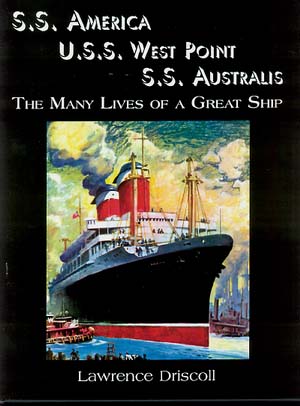
S.S. America ~ U.S.S. Westpoint ~ S.S. Australis
The Many Lives of a Great Ship

Lawrence Driscoll
The Glencannon Press / 2003
Hardcover / 260 pages
I confess to having a particular favoritism / preference for ‘single-ship’ books. As interesting and informative ‘comprehensive histories’ of the North Atlantic trade (and other routes) are, they generally tend to focus on the ‘better known’ ships at the expense of the ‘nautical wallflowers’ ~ those vessels built, launched, served and retired in relative obscurity. To say that the ss America is an ‘obscure’ liner is stretching it somewhat as the story of her faster, larger and more famous running mate, the ss United States, can not be told without paying polite homage to her, the ‘Big U’s’ prototype. However, previous coverage in print is brief and like an appetizer, leaves one wishing for more.
Lawrence Driscoll’s excellent history, a welcomed and long overdue tribute to this fine American liner, satisfies this hunger. Organized into ten chapters (plus Epilogue, End Notes and two Appendixes) the America’s story, from initial design (a brief overview of the United States Line is the lead-in chapter) to her present wrecked state, unfolds in sufficient detail to satisfy both the nautical historian and the lover of the technical. Of particular interest is Chapter Three, ‘Building the America’ which colorfully (and somewhat gritty) details the life of the shipyard, the men who built her and the conditions under which she was constructed, something that is too often glossed over in other narratives. It is the best I have read on the subject. Individual essays, in the spirit of the Time / Life book The Great Liners, are thoughtfully dispersed throughout, providing additional insight into the topic at large.
Of use to modelers? Although no assembly kit, either plastic or resin, exists of the America this publication does feature ‘shipbuilder style’ studies: a sectional diagram and all ‘general arrangement’ deck plans. Finally, a book devoted to the history of a single ship that does! Although one may wish that these were produced as foldouts (they are not), their presentation (aft / left and forward / right) does not extend ‘into’ the binding, which can be a real pain when one attempts to photocopy for other uses. The ‘mid-ship cut line’ is spaced about 1" from center, which allows for easy photocopying and splicing together without loss or distortion of information. Rounding out the technical drawings is a half-section through the machinery space showing all decks (the level of detail is captivating) and two side-profile drawings, one of the America as Trans-Atlantic liner and the other as the Greek flagged Australis. Although interesting, they are not of the same crisp penmanship as the ‘builder’s’ drawings (in particular, the Australis drawings eliminates the Promenade Deck overhang all together, a curious oversight), and perhaps should be taken at ‘face value’ as a modeling aid. However, the builder’s plans are of sufficient detail to enable one to embark on a ‘scratch-build’ project, following the ‘Onno technique’.
With this being said the book does have, in my opinion, one shortcoming. On most the text is on only one-half of the page, with the ‘inboard’ (at binding) half-page reserved for photographs, graphics and the like. Unfortunately, this publication is ‘photographically challenged’. I find this curious as other books feature photographs that could have been repeated, but are not. Too much of the book is ‘blank’, including four pages (within the ten chapters) containing nothing more than the page number and name of the chapter, a definite no-no in any book! Considering her 40 + years of service I can not imagine photographs are that scarce. For instance, in the chapter detailing her fitting out, only ten photographs are presented: six of first-class public rooms, three of cabins and one photograph of the tourist-class Smoking Room. No photos of America’s original third-class facilities are provided. If filler was required, deck plans showing the Chandris modifications / rebuilding would have been of interest, for comparison. Also of note, with exception of the back dust cover no color photographs are offered.
One other ‘minor irk’, and minor it is, is the ‘Epilogue’s’ reference to (and description of) the various ‘America Websites’ that one can access (for additional photos, no doubt!). As we all know internet sites can easily come and go thus in this regard this section, although well intended, may not stand the test of time and may become redundant within a couple of years, if not sooner.
In spite of these shortcomings this is an excellent book. It is well balanced, as as mentioned, provides sufficient detail without becoming too laborious. Without doubt it could have been much more and perhaps later editions will rectify the lack of photographs. Yet as a ‘stand alone’ it is a pleasurable voyage covering the conception, life (several lives actually) and unfortunate demise of a liner that has lived in the shadow of one more famous for too long. If you are one who appreciates publications devoted to ‘single ship’ histories, this is a highly recommended addition to your nautical library.
If you can not find this title at your favorite bookstore it is available ‘on-line’ from ‘The Nautical Mind Bookstore’.
Arjay ~ 12 / 03